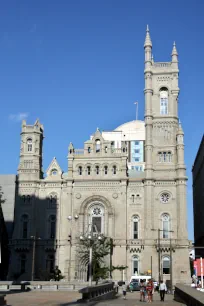Philadelphia’s Masonic Temple, one of the city’s most interesting architectural gems, is the home of The Grand Lodge of Free and Accepted Masons of Pennsylvania. Many of America’s Founding Fathers were Freemasons.


History
In 1867 the masons of Philadelphia purchased a lot for the construction of a masonic temple. They held a competition and selected a young Freemason, James Windrim, as the architect. Situated at Penn Square across the street from the then planned City Hall, the new temple was to reflect all the architectural styles of the Freemason’s mystic ancestors of Egypt, Greece, Italy, Germany, France, Scotland and England. The result was a building like none other, one that has been continuously acclaimed by architectural experts throughout the world.
The cornerstone for the $1.6 million (not counting furniture or decoration) Masonic Temple was laid on St. John the Baptist Day, June 24, 1868. The dedication occurred a little more than five years later and was marked by a grand parade that included 14,000 participants. Work on the lavish interior started fourteen years later and took fifteen years to complete. Most of the interior design is attributed to George Herzog, a Bavarian immigrant who had studied architecture in Munich, at the court of Ludwig I.
Architecture
The stone Norman-style exterior of the building comes from several sources. The main facade is of Cape Anne (Mass.) syenite (similar to granite) and the exteriors facing Juniper and Cuthbert streets are fashioned from Fox Island granite from Maine. As is tradition with the Masons, who were known as master builders, the stones were cut, squared, marked and numbered at the quarries and brought to the temple to be put together.
The tall, medieval style tower is prominent on the Philadelphia skyline and soars to more than 250 feet tall (76 meter), with foundations that are located about 31 feet (9.5 meter) below ground level.
Interior
Inside, the temple houses seven lodge halls that were designed to capture the seven “ideal” architectures, according to Free Masonry. These are Renaissance, Ionic, Oriental, Corinthian, Gothic, Egyptian, and Norman. No expense was spared in the decoration of these meeting halls, which feature magnificent murals, ornate furniture, and much more. Most are long with high, ornamented ceilings and were built in strict conformity with the principles of each architectural style. Even the staircases are breathtaking works of art. The most famous of these room is the Egyptian Hall, designed in 1889 after the temples of Luxor in Egypt. The decorations even include accurate hieroglyphics. Another famous room, the Oriental Hall (1896), was inspired by the Alhambra in Granada, Spain.
There are also several dining rooms within the structure as well as a Masonic library and museum, founded in 1908 and featuring artifacts from some of America’s earliest Masons, including George Washington; the masonic apron worn by the first president when he laid the first stone of the US Capitol in Washington, DC is on display here. The museum room is Byzantine in style. A small gift shop offers Masonic books, gifts, collectibles, regalia and jewelry.
Tours of the Masonic Temple are available several times per day, depending on the time of year.

